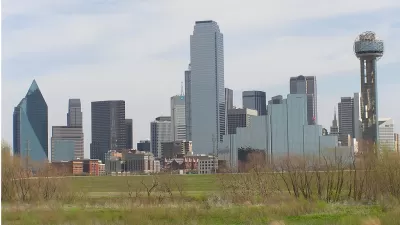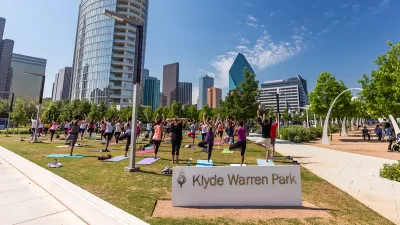Alan G. Brake looks at the ambitions of Dallas's newly opened Klyde Warren Park. Built atop a trenched highway, the park "attempts to merge sophisticated contemporary design with walkable urbanism" while uniting two downtown neighborhoods.
How far can a new five-acre park go towards reorienting Dallas's car-centered culture towards a more walkable, seamless, urban environment? Such is the question asked by Brake in his review of the newly opened highway-cap park, which was designed by the Office of James Burnett, a Houston-based landscape architecture firm.
"[B]ordered on one side by the Downtown Dallas Arts District—which includes buildings by Edward Larabee Barnes, Renzo Piano, Foster + Partners, OMA, SOM, I.M. Pei, and Allied Works—and on the other by the tony Uptown neighborhood," the park attempts to correct "dated urban renewal-era thinking" by weaving together the neighborhoods "that have long been divided by the trenched Woodall Rogers highway."
"Built on decking that spans the eight-lane highway, Klyde Warren Park packs numerous amenities into its three-block length, including a large performance stage, a children’s play area, croquet and putting greens, a restaurant designed by New York architects Thomas Phifer and Partners (currently under construction), table tennis, and plenty of movable tables and chairs. Curved paths lead visitors through allées of trees, but keep most of the park open for civic gatherings," notes Brake.
"Will Klyde Warren Park be the beginning of a better-planned, more pedestrian-friendly central Dallas? Or will it prove to be just the latest bauble in Dallas’ collection, a Lone Star version of Chicago’s Millenium Park without that city’s density?"
New nearby residential development and the potential reorientation of neighboring museums are positive signs that Dallas may be on the verge of "a dynamic and connected central city that can make its trophies shine."
FULL STORY: Crit> Klyde Warren Park

Planetizen Federal Action Tracker
A weekly monitor of how Trump’s orders and actions are impacting planners and planning in America.

Map: Where Senate Republicans Want to Sell Your Public Lands
For public land advocates, the Senate Republicans’ proposal to sell millions of acres of public land in the West is “the biggest fight of their careers.”

Restaurant Patios Were a Pandemic Win — Why Were They so Hard to Keep?
Social distancing requirements and changes in travel patterns prompted cities to pilot new uses for street and sidewalk space. Then it got complicated.

Maui's Vacation Rental Debate Turns Ugly
Verbal attacks, misinformation campaigns and fistfights plague a high-stakes debate to convert thousands of vacation rentals into long-term housing.

San Francisco Suspends Traffic Calming Amidst Record Deaths
Citing “a challenging fiscal landscape,” the city will cease the program on the heels of 42 traffic deaths, including 24 pedestrians.

California Homeless Arrests, Citations Spike After Ruling
An investigation reveals that anti-homeless actions increased up to 500% after Grants Pass v. Johnson — even in cities claiming no policy change.
Urban Design for Planners 1: Software Tools
This six-course series explores essential urban design concepts using open source software and equips planners with the tools they need to participate fully in the urban design process.
Planning for Universal Design
Learn the tools for implementing Universal Design in planning regulations.
Heyer Gruel & Associates PA
JM Goldson LLC
Custer County Colorado
City of Camden Redevelopment Agency
City of Astoria
Transportation Research & Education Center (TREC) at Portland State University
Camden Redevelopment Agency
City of Claremont
Municipality of Princeton (NJ)




























